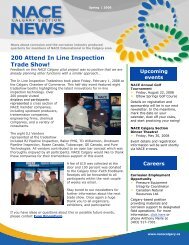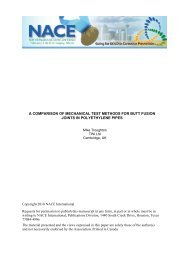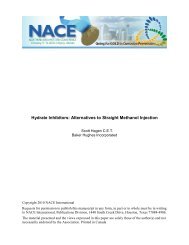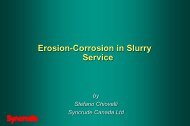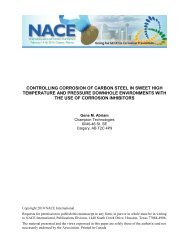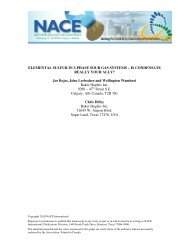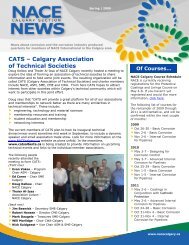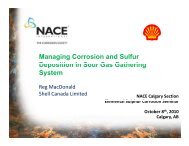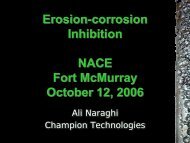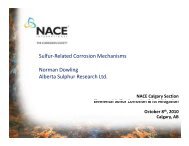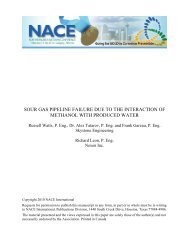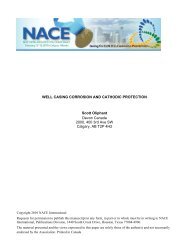CORROSION FAILURE IN A LINED SOUR GAS ... - NACE Calgary
CORROSION FAILURE IN A LINED SOUR GAS ... - NACE Calgary
CORROSION FAILURE IN A LINED SOUR GAS ... - NACE Calgary
Create successful ePaper yourself
Turn your PDF publications into a flip-book with our unique Google optimized e-Paper software.
<strong>CORROSION</strong> <strong>FAILURE</strong> <strong>IN</strong> A L<strong>IN</strong>ED <strong>SOUR</strong> <strong>GAS</strong> PIPEL<strong>IN</strong>E - PART 1:<br />
CASE HISTORY OF <strong>IN</strong>CIDENT<br />
L. Simon<br />
Shell Canada Energy<br />
Pincher Creek, Alberta<br />
R. MacDonald<br />
Shell Canada Energy<br />
<strong>Calgary</strong>, Alberta<br />
K. Goerz<br />
Shell Canada Energy<br />
<strong>Calgary</strong>, Alberta<br />
Copyright 2010 <strong>NACE</strong> International<br />
Requests for permission to publish this manuscript in any form, in part or in whole must be in<br />
writing to <strong>NACE</strong> International, Publications Division, 1440 South Creek Drive, Houston,<br />
Texas 77084-4906.<br />
The material presented and the views expressed in this paper are solely those of the<br />
author(s) and not necessarily endorsed by the Association. Printed in Canada
<strong>CORROSION</strong> <strong>FAILURE</strong> <strong>IN</strong> A L<strong>IN</strong>ED <strong>SOUR</strong> <strong>GAS</strong> PIPEL<strong>IN</strong>E - PART 1:<br />
CASE HISTORY OF <strong>IN</strong>CIDENT<br />
L. Simon<br />
Shell Canada Energy<br />
Pincher Creek, Alberta<br />
R. MacDonald<br />
Shell Canada Energy<br />
<strong>Calgary</strong>, Alberta<br />
K. Goerz<br />
Shell Canada Energy<br />
<strong>Calgary</strong>, Alberta<br />
ABSTRACT<br />
A failure due to internal corrosion occurred on a lined sour gas pipeline. The<br />
pipeline was a steel pipeline installed initially with a polyamide liner in 2001 and<br />
then re-lined in 2003 with a high density polyethylene (HDPE) liner. Neither of<br />
the liners had breached in service, yet corrosion behind the liner occurred and<br />
led to failure of the pipeline. The cause of the failure and the strategy to manage<br />
corrosion behind the liner in a lined pipeline is discussed. The strategy involved<br />
the development of an attributes model, the use of a new inline inspection tool<br />
along with changes to the operating and integrity reference plans of the lined<br />
sour gas pipelines.<br />
Keywords: sour, failure, pipeline, liner, corrosion, CO2, H 2 S, methanol,<br />
polyamide, HDPE<br />
<strong>IN</strong>TRODUCTION<br />
In November 2007 Shell Canada Energy (Shell) experienced a sour gas release<br />
on the Waterton Screwdriver Creek Pipeline (the SC pipeline).<br />
The SC pipeline is a 2.6km long x 168.3mm OD (NPS 6) x 5.6mm WT sour gas<br />
pipeline. The SC pipeline is licensed to a maximum operating pressure of 12,400<br />
kPag and a maximum H2S concentration of 32%. The pipeline was carrying<br />
natural gas containing approximately 21 per cent H2S and operating at a<br />
pressure of approximately 4300 kPa at the time of the incident. The operating<br />
temperature at the SC pipeline inlet, with a well site heater, ran at approximately<br />
45C.<br />
1
The SC pipeline was installed in November 2001 as a new steel pipeline with a<br />
polyamide liner. The SC pipeline transported sour gas from the well to a junction<br />
where it tied in with other sour gas pipelines as part of the Castle River gathering<br />
system. Sour gas first flowed into the SC pipeline from the well in early 2003. A<br />
third party gas well was also tied into the SC pipeline in mid-2003.<br />
Subsequent to polyamide liner collapse and breaches in other polyamide lined<br />
pipelines in the neighboring Carbondale gathering system (1,2), the polyamide<br />
liner in the SC Pipeline was removed and replaced with an externally grooved<br />
HDPE liner. The re-lined SC pipeline was put back into service in December<br />
2003. Sour gas from both wells flowed into the SC Pipeline until the November<br />
2007 failure, just under four years of service time.<br />
BACKGROUND ON L<strong>IN</strong>ER USE<br />
Liners have been used in oilfield pipeline applications in Alberta since the mid-<br />
70's with the initial use dominated by rejuvenation of produced water injection<br />
system pipelines. HDPE liners offered a barrier to corrosive produced water<br />
while the outer steel pipeline provided the strength for the pressure containment.<br />
Beginning in the late 1980s HDPE liners were increasingly being used in the<br />
rejuvenation of high water-cut oil well production pipelines that were suffering<br />
from internal corrosion. A few applications were used in sour gas pipelines that<br />
had corrosive fluid properties.<br />
Previous company liner installations included two liners in wet sour gas pipelines<br />
in the 1990s, one in the South Waterton field and one in the Jumping Pound field.<br />
Both were installed as liners in existing steel pipelines to manage the internal<br />
corrosion threats. These two liners were traditional HDPE liners that were<br />
externally smooth. Both lined pipelines operated successfully for a number of<br />
years (3).<br />
In the North Waterton fields, lined pipelines were first installed in 2000 into<br />
existing steel pipelines that had experienced internal corrosion damage. The<br />
initial liners used here were polyamide, which was capable of higher operating<br />
temperatures than HDPE. The success led to the installation of additional liners<br />
in new pipelines being installed in the area.<br />
In 2002, the Carbondale NPS 6 polyamide liner was found to have breached in<br />
several locations. The Castle River NPS 8 polyamide liner was also found to<br />
have breached. Internal corrosion was found in the Carbondale pipeline. The<br />
corrosion was caused by brine and elemental sulphur coming into contact with<br />
the steel pipe due to the liner breach. As a result of these breaches, polyamide<br />
liners were removed and replaced with the thicker walled, externally grooved<br />
HDPE liners in Carbondale and Castle River pipelines.<br />
2
None of the polyamide liner breaches resulted in a pipeline leak, due to the steel<br />
pipe integrity. The cause of the polyamide liner breaches was determined to be<br />
a result of:<br />
1. The main failure mechanism was longitudinal buckling (inversion) of the<br />
liners. The key factor was ineffective venting of the annulus especially over<br />
large line pressure fluctuations. Other factors such as loose fit, thin wall<br />
design and chemical additives such as methanol and Dimethyl Disulfide<br />
(DMDS) accelerated the failures but were not considered to be the dominant<br />
factors.<br />
2. A second failure mechanism involved long duration shut-ins. This failure<br />
mechanism involved tensile overload of the liner due to production fluids and<br />
additives stripping extractables (plasticizer and oligomer) from the polyamide<br />
liner material. Components of the production fluids/additives replace these<br />
extractables during normal operations, but when shut-in and/or depressured<br />
for an extended period, the production fluids/additives vaporize leading to<br />
shrinkage and subsequent tensile overload of the liner.<br />
At the time that the polyamide liners were replaced in the Carbondale and Castle<br />
River pipelines, a few short, single segment polyamide lined pipelines in the<br />
North Waterton Field were confirmed to be intact and continued successful<br />
operation. These short pipelines were found to not have any evidence of liner<br />
collapse. It was confirmed that these liners were not exposed to the detrimental<br />
additives which stripped extractables from the liner and that would affect the<br />
properties of the liner, which also explains why these liners did not experience a<br />
tensile overload failure during long duration shut downs.<br />
After removal of the polyamide liner and prior to installing the HDPE liner, the SC<br />
Pipeline was inspected visually at the ends of each flanged segment, by<br />
evaluation of two cut outs and with a tethered inspection tool in selected<br />
locations. Eight selected pipeline locations along the SC Pipeline, including the<br />
subject failed portion, each about 80m in length (the capability of the tethered<br />
inspection tool at that time), were inspected. The visual inspections did not<br />
identify any significant corrosion and the tethered inspection tool did not indicate<br />
the presence of any internal corrosion that exceeded the minimum detection limit<br />
of the electronic tool. The HDPE liner was installed and the pipeline resumed<br />
operation in December 2003. The SC pipeline remained in service until the<br />
pipeline failure occurred in November 2007.<br />
<strong>FAILURE</strong> ANALYSIS<br />
The pipeline failure was the result of an axial split in the steel pipe about 300mm<br />
in length with a maximum width of 60mm at centre. The failure occurred 27m<br />
downstream of Vent 6 as shown in the elevation profile (Figure 3). It was the<br />
result of tensile overload of the steel pipe in a localized area where internal<br />
corrosion had removed almost 90 per cent of the pipe wall (Figure 1 and 2).<br />
3
There was no evidence of a breach in the liner prior to the failure of the steel<br />
portion of the pipeline.<br />
In lined (thermoplastic liners) sour gas pipelines, it is known that sour gas<br />
permeates the liner. The design premise is for a protective iron sulphide scale to<br />
form on the steel pipe since no chlorides or elemental sulphur will permeate the<br />
liner. If intact, this scale can provide the steel with effective corrosion protection.<br />
In this case, it appears that the protective iron sulphide scale had not existed in a<br />
uniform manner, and as a result corrosion was able to occur in localized patches.<br />
In those locations, a paste-like mixture of iron sulphide corrosion product<br />
suspended in an acidic liquid, was found sandwiched in the annulus between the<br />
HDPE liner and the steel pipe (like the example shown in Figure 4). The liquid<br />
component was believed to be primarily methanol, which is used in the pipeline<br />
for a variety of purposes, including hydrate control. Methanol was continuously<br />
injected into the production fluids to prevent hydrates and also was used<br />
occasionally to flush parts of the annulus vent system of the pipeline, thus<br />
establishing its presence in the liner annulus. There was no evidence that<br />
chlorides, bacteria, or elemental sulphur played a role in the corrosion process.<br />
Further investigation identified the following major factors that contributed to the<br />
failure:<br />
• Discrete patches of non-protective scale associated with minor corrosion that<br />
had occurred when the pipeline was operated with a polyamide liner,<br />
remained when the HDPE liner was installed. These discrete patches of nonprotective<br />
scale rendered the batch inhibitor ineffective at those locations and<br />
also prevented the formation of protective scale, thus allowing localized<br />
corrosion to occur.<br />
• Corrodents present in the annulus from a number of sources did not allow the<br />
formation of protective scales to occur and further promoted and provided the<br />
conditions for ongoing corrosion. Methanol and water (the main corrodents),<br />
present at high concentrations and under the right conditions in the annulus,<br />
promoted corrosion.<br />
• The non-protective scale, together with liquid and solid debris, partially<br />
blocked the annulus vent system, creating poor annulus communication and<br />
high annulus pressure that, with the presence of the corrodents, created a<br />
more acidic and corrosive low pH environment. These conditions exacerbated<br />
the corrosion.<br />
• There was insufficient flow/velocity in the annulus vent system to effectively<br />
sweep liquids (and solids) from the annulus. The complex flow path and lowflow<br />
conditions, especially adjacent to the bellholes, created liquid traps<br />
preventing the liquids and solids from being swept from the annulus.<br />
4
Other minor factors that may have contributed to the failure were identified as<br />
follows:<br />
• Prior to installing the HDPE liner, the SC pipeline was not water flushed in<br />
connection with a hydrotest or inspection tool run. This could have helped<br />
remove or dilute Debris and/or Corrodents.<br />
• Formic acid, used for well stimulation, might have also permeated the liner as<br />
a vapor and further contributed to the low pH condition in the pipeline<br />
annulus. However, this is not believed to have played a significant role in the<br />
failure.<br />
ACTION PLAN<br />
A five-step action plan was developed to further investigate the scenarios that<br />
were identified as possible causes of the incident and to develop a plan to ensure<br />
the safe start-up and ongoing integrity of the SC pipeline.<br />
Step 1: Continued Review of Contributing Factors, Conditions, Events—<br />
Reviewed factors, conditions, and events that contributed to the incident, with the<br />
objective of better understanding the role of the various contributing factors in the<br />
incident and the extent to which these factors may be unique to the failure<br />
location. This is all with a view to further understanding the conditions that might<br />
cause corrosion and how those conditions might occur.<br />
Step 2: Model Development—This involved developing a model to help improve<br />
understanding of the failure mechanism and assess the likelihood that similar<br />
factors, conditions, and events exist in the remainder of the pipeline and in other<br />
lined sour gas pipelines. The model was initially developed based on the<br />
information that was available at the time. The model assisted in developing the<br />
integrity plan and start-up plan set out in Steps 4 and 5 respectively.<br />
Step 3: Model Validation—This involved developing and executing sufficient<br />
inspections, tests, and other methods to validate the model developed in Step 2.<br />
Step 4: Integrity Plan—To confirm the validity of the model, it was necessary to<br />
complete certain other activities, that included inspections, tests, sampling, and<br />
laboratory testing. It was expected that inspection activities would constitute the<br />
majority of activities in this step. Inspections were completed to ensure that the<br />
model accurately predicted if and where corrosion can be expected. After the<br />
model developed in Step 2 was validated, Step 4 of the Action Plan involved<br />
developing and executing a plan to ensure the integrity of the pipeline prior to<br />
start-up. The plan may involve inspections, hydrotesting, liner integrity<br />
verification, cutouts, and repairs.<br />
Step 5: Start-up Plan—This involved developing and executing a plan to restart<br />
the pipeline. The plan included, as necessary, changes to operating<br />
envelopes/windows; inspection, mitigation, and monitoring requirements; and<br />
operating and maintenance practices.<br />
5
Steps 1 through 5 were completed and have allowed the successful restart of the<br />
majority of the lined pipelines. The SC pipeline had extensive damage and<br />
remains out of service.<br />
Investigation<br />
The design premise for the lined pipelines was as follows:<br />
• Liner is a "barrier" to direct contact of the steel carrier pipe ID surface with<br />
the corrosive produced fluids<br />
• Liner is "permeable" (by design). Gases can permeate the liner and collect<br />
in the liner/steel annulus. Venting of the annulus is required to avoid the<br />
case of annulus pressure exceeding the pipeline pressure enough to<br />
collapse and fail the liner<br />
• Protective iron sulfide scales form on the steel carrier pipe ID surface<br />
resulting in low corrosion rates<br />
• Scale disrupters (e.g. chlorides, elemental sulfur) which can breakdown<br />
the protective iron sulfide scales cannot permeate the liner<br />
• Should a failure (breach) of the liner occur, the liner integrity monitoring<br />
strategy (annulus pressure monitoring system) would alert operations to<br />
the condition in a timely manner for measures to be taken before a loss of<br />
containment would occur<br />
Subsequent to the problems encountered with the polyamide liners, efforts were<br />
made to find ways to avoid liner collapse. HDPE was chosen as a new liner<br />
material for its resistance to damage by methanol and sulphur solvents. The<br />
HDPE liners were designed with thicker walls and external grooves in order to<br />
prevent liner collapse and allow permeated gases to vent through the annulus<br />
vent system. The externally grooved liners were designed with vent tubing<br />
across flange connections (1,2). The vented gas flows through a scrubber where<br />
the gas is sweetened.<br />
This paper will not go into detail on the corrosion that occurred, since that is<br />
covered in the companion paper Corrosion Failure in a Lined Sour Gas Pipeline -<br />
Part 2: Role of Methanol in Corrosion Behind Liner (8).<br />
The internal corrosion of the SC pipeline meant that something had disturbed the<br />
normally protective iron sulfide scale. Within the industry it is known that certain<br />
contaminants can cause iron sulfide scale to become non-protective. The list of<br />
contaminants that can disrupt iron sulphide scale includes:<br />
• chlorides<br />
• elemental sulphur<br />
• low pH<br />
• methanol<br />
6
In bare steel pipelines transporting wet sour gas, the top two contaminants in the<br />
list above are the primary internal corrosion drivers that allow the wet-H 2 S<br />
corrosion to continue without the formation of a protective iron sulfide scale (1,7).<br />
Low pH can lead to dissolution of the iron sulfide scale. Dissolved acid gases,<br />
H 2 S and CO2, lower the pH and the presence of any acids would further lower<br />
the pH of the water.<br />
In 2003, it was believed that the annulus would contain wet sour gas, but the<br />
amount of water and methanol would be small. It was believed that wet sour gas<br />
in the annulus, without chlorides, elemental sulphur and large amounts of<br />
methanol, would cause only a low corrosion rate and protective scale would<br />
develop, which would also reduce corrosion rates.<br />
Subsequent to the failure, Shell developed the Process Model, which is a<br />
process engineering simulation, to better understand the operation of the HDPE<br />
liner and the conditions in the annulus. It is now understood that 90% of the<br />
liquid methanol injected into the production at the well site, is vaporized<br />
downstream of the well site heater. This creates a relatively high vapor pressure<br />
in the production fluids and leads to greater than expected permeation of<br />
methanol vapor through the HDPE liner into the annulus.<br />
The Process Model also shows that the gas that permeates through the HDPE<br />
liner into the annulus will include small amounts of methanol vapor and water<br />
vapor. The permeated annulus gas is below the dew point of water and<br />
methanol at all annulus pressures experienced. Therefore, it is now understood<br />
that the small quantities of methanol and water vapor that would permeate<br />
through the HDPE liner into the annulus would condense and collect within the<br />
annulus. Liquid methanol added directly into the annulus would also exist as<br />
vapor or liquid within the annulus, depending upon the pressure and temperature<br />
in the annulus.<br />
The Process Model also suggests that the liquid condensed in the annulus will be<br />
dominated by water and methanol. Initially, the water volume would exceed the<br />
methanol volume, but the latter would still be significant. Subsequently, as<br />
annulus gas flows through the annulus vent system towards the scrubber<br />
(located at the end of the Pipeline), more vapors may condense, as conditions<br />
allow. The Process Model shows that the long jumper vent tubing used on the<br />
Pipeline at the flange bell holes would lead to condensation, due to greater<br />
cooling in this part of the annulus vent system. The Process Model shows that<br />
condensed liquids from this gas stream will have more methanol than water in<br />
the liquid. Other studies on the behaviour of methanol in unlined sour gas<br />
pipelines are consistent with the model results (6).<br />
Inspection of the failed SC pipeline and the other lined pipelines in sour gas<br />
service has confirmed that the use of continuous methanol injection was a<br />
7
common attribute (threat) that led to mainly isolated pitting damage in a number<br />
of the other lined pipelines. This kind of corrosion is different than the corrosion<br />
that caused the failure of the SC pipeline. The SC pipeline was the only pipeline<br />
that experienced the larger patches of corrosion damage that resulted in the<br />
failure. It was the size and location of these corrosion patches that supported the<br />
belief that the corrosion initiated at the failure location during the polyamide liner<br />
service.<br />
With findings gained from the investigation, a line-by-line assessment was<br />
carried out of all Shell’s other lined sour gas pipelines in Alberta, including the<br />
shut-in lined pipelines. As the assessments of the pipelines were completed,<br />
individual plans were submitted to the regulator in support of the restart of each<br />
of the pipelines, along with appropriate measures to help ensure the long-term<br />
integrity of each pipeline.<br />
Liner Attributes Model<br />
The attributes model consists of a spreadsheet containing the various factors that<br />
were understood that may have contributed to the conditions that caused the<br />
failure. Using the failed SC pipeline as the base case, all other lined pipelines<br />
within the system were assessed to determine if the same contributing factors<br />
might be present. The information contained in the attributes model was then<br />
used to flag other lined pipelines that may be expected to have the same<br />
conditions that eventually resulted in the failure of the SC pipeline. It should be<br />
noted that just having some or all of the same conditions present does not mean<br />
that a particular pipeline has corrosion damage like that experienced in the SC<br />
pipeline.<br />
Using the information in the attributes model, certain inspections and other<br />
activities were planned to assist with validation of the model. The verification<br />
activities were designed to:<br />
• confirm if some or all of the contributing factors were present in a specific<br />
pipeline or not;<br />
• establish if corrosion damage was present similar to what caused the<br />
failure in the SC pipeline; and<br />
• improve the accuracy of the attributes model by updating it, using the<br />
information from the above validation activities.<br />
Based on the work completed to date in respect of the attributes model, the<br />
following has been concluded:<br />
• Conditions that contributed to the failure were not unique to the area of the<br />
SC pipeline that experienced the failure.<br />
• Similar conditions were expected to exist in the remainder of the SC<br />
pipeline. This was confirmed by:<br />
8
o In-line inspections (ILI) using magnetic-flux leakage and<br />
electromagnetic type inspection tools completed on the remainder<br />
of Segment 6 (the failed segment) and Segment 5 (the segment<br />
immediately upstream of Segment 6) where corrosion damage<br />
similar to that which existed at the failure site has been found.<br />
o Inspections by radiographic (RT) methods of piping in the flange<br />
pair bellholes along the Pipeline indicate corrosion damage and<br />
liner liftoff which appear to be similar to the features noted at the<br />
failure location.<br />
• The combination of conditions that may have contributed to the failure of<br />
the SC pipeline is not present in other lined pipelines. However, some of<br />
the conditions that may have contributed to the failure in the SC pipeline<br />
are present in other lined pipelines in the system.<br />
• The attributes model indicated that a lined sour gas pipeline in the Burnt<br />
Timber Complex had many (but not all) of the same attributes as the SC<br />
pipeline and therefore may also be susceptible to similar corrosion<br />
damage. This pipeline was inspected to determine if similar corrosion was<br />
present. These inspection activities have not identified any large areas of<br />
corrosion damage similar to those found on the SC pipeline. One<br />
significant reason that corrosion was present in the SC pipeline, but not<br />
the Burnt Timber pipeline is likely because of the fact that methanol was<br />
not continuously injected into the Burnt Timber pipeline for hydrate control.<br />
The results of our inspection work found only minor corrosion in the inspected<br />
pipelines (other than the SC pipeline). The results to date are encouraging and<br />
are consistent with the conclusions regarding the major factors that caused the<br />
failure of the SC pipeline. The results also provide validation for the attributes<br />
model.<br />
Inspection<br />
Work was undertaken with an Alberta based company to modify an existing<br />
electromagnetic inline inspection (ILI) tool to be used to determine the integrity of<br />
the steel pipeline in a lined pipeline with the liner remaining in place. Field trials<br />
demonstrated that the tools are capable of inspecting for corrosion of the steel<br />
carrier pipe through the liner and inspection work on the lined sour gas pipelines<br />
was completed. This was a new application of the technology and was developed<br />
in response to this incident.<br />
Inspections have been completed on the majority of the lined pipelines and to<br />
date has not detected any other significant corrosion damage like that which<br />
caused the failure in the SC Pipeline. Most of the pipelines were inspected with<br />
an ILI tool capable of inspecting the steel pipe integrity with the HDPE liner still in<br />
place.<br />
During log verifications and bell hole inspections minor isolated pitting adjacent to<br />
the external grooves in the HDPE liner was noted in a number of pipelines. This<br />
9
type of damage has been found in lined pipelines of varying age, ie; from 2 to 7<br />
years and all to similar depths. The depth of such pits was as much as 28% of<br />
the pipe wall in one pipeline. This pitting is like the axial pitting shown in Figure 5<br />
which is approximately 30% of the pipe wall and adjacent to the external grooves<br />
on the HDPE liner.<br />
The verification dig findings confirmed corrosion activity on recently lined<br />
pipelines that had received continuous methanol injection into production fluids<br />
for hydrate control. In one segment of HDPE lined pipeline that had less than<br />
one year of service, shallow (4%WT) grooving was detected adjacent to the<br />
external grooves in the HDPE liner (Figure 6). This suggests that, while different<br />
than the corrosion mechanism that caused the SC pipeline failure, corrosion<br />
behind HDPE liners in sour gas pipelines can be a threat where methanol is<br />
continuously injected into the production fluids. Consideration should be given to<br />
taking steps to properly assess and manage the risk of such corrosion.<br />
Changes in Operating Practices and Integrity Reference Plans<br />
With the experience and learnings from this incident changes were implemented<br />
to the operating practices and integrity reference plans for lined sour gas<br />
pipelines. The main changes are:<br />
• Continuous injection of methanol into production fluids for hydrate control<br />
is not allowed.<br />
• If short-term use of methanol is required, the pipeline is pigged afterwards<br />
to remove the methanol from the environment.<br />
• The use of methanol is no longer allowed for clearing or de-icing the<br />
annulus vent systems without prior assessment and approval.<br />
• Monitoring corrosion rates using on-line corrosion monitoring devices at<br />
two selected locations with prior corrosion damage to measure the<br />
effectiveness of the above mitigation items.<br />
• Any liquids and/or solids collected from the annulus vent system are<br />
sampled for analysis.<br />
• Periodic inspection using ILI and bell hole NDE.<br />
CONCLUSIONS<br />
1. Methanol permeation into the annulus vent system on polyamide and<br />
HDPE lined pipelines in wet sour gas service is a credible internal<br />
corrosion threat. This threat is magnified in polyamide lined pipelines but<br />
is also a threat in HDPE lined pipelines.<br />
2. This internal corrosion threat needs to be understood and managed<br />
effectively to avoid internal corrosion damage.<br />
3. The kind of damage seen in the failed pipeline has not been observed in<br />
any other operated pipeline inspected to date. Isolated internal corrosion<br />
pitting to approximately 25% depth was observed in a number of the lined<br />
10
pipelines. The common attribute in these pipelines was the continuous<br />
use of methanol for hydrate control.<br />
4. The effectiveness of the changes to the operating practices described<br />
above in managing corrosion continues to be assessed through enhanced<br />
monitoring activities. To date we have seen positive monitoring results<br />
since the implementation of the changes to the operating practices.<br />
5. Inspection tools have been developed and used for the inspection of the<br />
steel pipe in a lined pipeline without removal of the liner.<br />
6. Permeability of methanol and water through liner materials has been reevaluated<br />
and with this knowledge, it is apparent that the liner annulus<br />
may contain 3 phases; sour gas, hydrocarbon liquids and an aqueous<br />
phase. The removal of liquids and solids from the annulus vent system<br />
can be difficult to achieve and accumulation of solids and liquids in the<br />
annulus can occur. Further research on this mechanism is warranted.<br />
7. With the vapor pressure of methanol being four times higher than that of<br />
water, the effective permeation rate of methanol through the HDPE liner is<br />
expected to be about four times that of water.<br />
8. Lined pipeline operators that have used methanol for hydrate control in<br />
sour gas pipelines may want to consider inspection of those pipelines.<br />
More tools and techniques are now available that allow ILI of the pipelines<br />
and/or spot inspections.<br />
ACKNOWLEDGMENTS<br />
The authors wish to thank Shell Canada Energy for permission to publish this<br />
paper.<br />
REFERENCES<br />
1. A Review of Methods for Confirming Integrity of Thermoplastic Liners - Field<br />
Experiences, Goerz, Simon, Little & Fear, Corrosion2004, Paper 04703<br />
2. Learnings From Thermoplastic Liner Failures in Sour Gas Pipeline Service<br />
and Replacement Liner Design and Installation, Szklarz & Baron,<br />
Corrosion2004, Paper 04702<br />
3. Non-Metallic Liners for Gas/Condensate Pipelines, Szklarz, Baron &<br />
MacLeod, Corrosion2000, Paper 00783<br />
4. Corrosion Failure in a Lined Sour Gas Pipeline - Part 2: Role of Methanol in<br />
Corrosion Behind Liner, MacDonald et al, <strong>NACE</strong> NAWC February, 2010<br />
5. Materials Design Strategy: Effects of H2S/CO2 Corrosion on Materials<br />
Selection Paper 06121 Bijan Kermani, KeyTech; John W. Martin and Khlefa<br />
A. Esaklul, <strong>NACE</strong> <strong>CORROSION</strong>2006<br />
6. Corrosion Experienes and Inhibition Practices in Wet Sour Gas Gathering<br />
Systems, D. Ho-Chung Qui and A. Williamson, Paper #87046, Nace<br />
Corrosion 1987<br />
11
FIGURE 1 - Failure after insulation and coating removal<br />
FIGURE 2 - ID of the Steel Pipe at the Failure<br />
12
Waterton 61 Elevations<br />
1440<br />
1430<br />
W aterton 61 Elevations<br />
Vent Sites<br />
Cut-Out Inspection Area<br />
VuPipe Inspection End Points<br />
Leak<br />
1420<br />
Elevation, meters<br />
1410<br />
1400<br />
1390<br />
1380<br />
1370<br />
1360<br />
0<br />
50<br />
100<br />
258<br />
400<br />
500<br />
540<br />
603<br />
660<br />
970<br />
1030<br />
1060<br />
1117<br />
1380<br />
1560<br />
1660<br />
1755<br />
Distance from Waterton 61, meters<br />
1785<br />
2125<br />
2206<br />
2270<br />
2396<br />
2520<br />
2565<br />
2700<br />
2827<br />
FIGURE 3 - SC Pipeline Elevation Profile and Liner Vent Location Detail<br />
FIGURE 4 - Scale build-up and Metal loss at Bulge in Pipe Cut Out<br />
13
FIGURE 5 - Band of General Wall Loss (50% Loss) and Isolated Pitting (25-<br />
30% Loss) adjacent to external grooves in the HDPE liner<br />
FIGURE 6 - Shallow Corrosion on Steel Pipe ID Adjacent to External Grooves<br />
in HDPE Liner<br />
14



